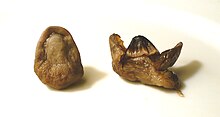This is an old revision of this page, as edited by 67.158.72.247 (talk) at 16:46, 31 October 2009 ("pink spore print, which is white"? no.). The present address (URL) is a permanent link to this revision, which may differ significantly from the current revision.
Revision as of 16:46, 31 October 2009 by 67.158.72.247 (talk) ("pink spore print, which is white"? no.)(diff) ← Previous revision | Latest revision (diff) | Newer revision → (diff)
| Paddy straw mushrooms | |
|---|---|

| |
| Two paddy straw mushrooms, the one on the right opened to reveal the cap inside | |
| Scientific classification | |
| Kingdom: | Fungi |
| Division: | Basidiomycota |
| Class: | Agaricomycetes |
| Order: | Agaricales |
| Family: | Pluteaceae |
| Genus: | Volvariella |
| Species: | V. volvacea |
| Binomial name | |
| Volvariella volvacea (Bulliard ex Fries) Singer | |
| Volvariella volvacea | |
|---|---|
| Gills on hymenium | |
| Cap is conical or umbonate | |
| Hymenium is free | |
| Stipe has a volva | |
| Spore print is salmon | |
| Ecology is saprotrophic | |
| Edibility is edible | |
Volvariella volvacea (also known as straw mushroom or paddy straw mushroom; syn. Volvaria volvacea, Agaricus volvaceus, Amanita virgata, Vaginata virgata) is a species of edible mushroom cultivated throughout East and Southeast Asia and used extensively in Asian cuisines. In Chinese, they are called cǎogū (草菇, lit. "straw mushroom"), and in Vietnamese they are called nấm rơm.
They are often available fresh in Asia, but are more frequently found in canned or dried form outside their nations of cultivation.
Straw mushrooms are grown on rice straw beds and picked immature, before the caps open. They are adaptable and take 4-5 days to mature, and are most successfully grown in subtropical climates with high annual rainfall. There is no record of their cultivation before the 19th century.
They resemble poisonous death caps, but can be distinguished by their pink spore print; the spore print is white for death caps. Nevertheless, people have been poisoned (sometimes fatally) making this mistake.
References
- ^ Hsiung, Deh-Ta (2006). The Chinese Kitchen. London: Kyle Cathie Ltd. pp. 186–87. ISBN 1-85626-702-4.
External links
- Straw Mushroom
- http://www.indexfungorum.org/Names/SynSpecies.asp?RecordID=307802
- http://www.indexfungorum.org/Names/NamesRecord.asp?RecordID=307802
This fungus-related article is a stub. You can help Misplaced Pages by expanding it. |